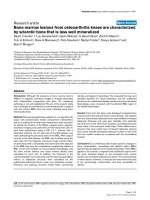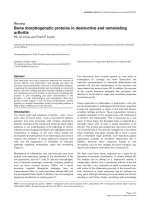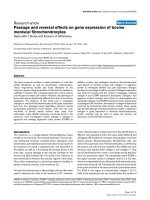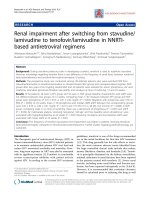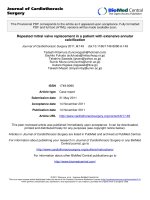Báo cáo y học: "Bone healing after median sternotomy: A comparison of two hemostatic device" pdf
Bạn đang xem bản rút gọn của tài liệu. Xem và tải ngay bản đầy đủ của tài liệu tại đây (710.88 KB, 8 trang )
RESEARC H ARTIC LE Open Access
Bone healing after median sternotomy: A
comparison of two hemostatic devices
Rikke F Vestergaard
1,2
, Henrik Jensen
1,2
, Stefan Vind-Kezunovic
1,2
, Thomas Jakobsen
3
, Kjeld Søballe
3
,
John M Hasenkam
1,2*
Abstract
Background: Bone wax is traditionally used as part of surgical procedures to prevent bleeding from exposed
spongy bone. It is an effective hemostatic device which creates a physical barrier . Unfortunately it interferes with
subsequent bone healing and increases the risk of infection in experimental studies. Recently, a water-soluble,
synthetic, hemostatic compound (Ostene®) was introduced to serve the same purpose as bone wax without
hampering bone healing. This study aims to compare sternal healing after application of either bone wax or
Ostene®.
Methods: Twenty-four pigs were randomized into one of three treatment groups: Ostene®, bone wax or no
hemostatic treatment (control). Each animal was subjected to midline sternotomy. Either Ostene® or bone wax was
applied to the spongy bone surfaces until local hemostasis was ensured. The control group received no hemostatic
treatment. The wound was left open for 60 min before closing to simulate conditions alike those of cardiac
surgery. All sterni were harvested 6 weeks after intervention.
Bone density and the area of the bone defect were determined with peripheral quantitative CT-scanning; bone
healing was displayed with plain X-ray and chronic inflammation was histologically assessed.
Results: Both CT-scanning and plain X-ray disclosed that bone healing was significantly impaired in the bone wax
group (p < 0.01) compared with the other two groups, and the former group had significantly more chronic
inflammation (p < 0.01 ) than the two latter.
Conclusion: Bone wax inhibits bone healing and induces chronic inflammation in a porcine model. Ostene®
treated animals displayed bone healing characteristics and inflammatory reactions similar to those of the control
group without application of a hemostatic agent.
Background
Cardiac surgery is predominantly performed through a
median sternotomy. Today more than 700,000 sterno-
tomies are performed each yea r in the USA alone [1].
This procedure provides excellent access to all med iast-
inal structures, is quick and easy to perform, and is well
tolerated by most patients. Although complications are
relatively rare, they are serious when they occur.
Immediate complications are intra- and postoperative
bleeding. These predispose to postoperative lack of bone
healing which can lead to pseudoarthrosis and dehis-
cence or even infection and sternal erosion. To prevent
bleeding, bone wax is traditionally used to physically
block blood from oozing out of the spongy bone during
operations whi ch are performed during full hepariniza-
tion. Bone wax consists of sterilized white-bleached hon-
eybees wax (cera alba) blended with a softening agent,
such as paraffin. The product is very effective for dimin-
ishing the amount of intraoperative bleeding. Bone wax
unfortunately has significant potential long-term side
effects. Thus, experimental studies have shown that
when a bone defect is treated with bone wax, the num-
ber of bacteria needed to initiate an infection is reduced
by a factor of 10,000 [2-4]. Furthermore, bone wax acts
as a physical barrier which inhibits osteoblasts from
reaching the bone defect and thus impair bone healing
[5,6]. Once applied to the bone surface, bone wax is
usually not resorbed [7].
* Correspondence:
1
Dept. of Cardio-Thoracic and Vascular Surgery, Aarhus University Hospital,
Skejby, Brendstrupgårdsvej 100, 8200 Aarhus N, Denmark
Full list of author information is available at the end of the article
Vestergaard et al. Journal of Cardiothoracic Surgery 2010, 5:117
/>© 2010 Vestergaard et al; licensee BioMed Central Ltd. This is an Open Access article distributed under the terms of the Creative
Commons Attribution License ( which permits unrestricted use, distribution, and
reproductio n in any medium, provi ded the original work is prope rly cit ed.
Since intraoperativ e bleeding from the sternum can be
excessive surgeons are often forced to balance the
risk of blood loss against the long-term side effects of
bone wax.
A new water-soluble polymer wax (Ostene®) has
recently been introduced as a resorbable alternative to
bone wax [8,9]. Ostene® is used in the same way as bone
wax to immediately ensure hemostasis by sticking to the
bone surface and thus creating a physical barrier. The
biocompatible polym ers used in Ostene® have been
shown to be eliminated from the body and remain
unchanged through renal clearance [10]. The properti es
of Ostene® are claimed to mimic the ideal hemostatic
properties of bone wax while avoiding the inherent risks
of infection and impaired bone healing associated with
the use of traditional bone wax. Based on this we
hypothesized that Ostene® would have a lesser impairing
effect on bone healing and lead to a reduced inflamma-
tory response compared to bone wax. Accordingly we
aimed to compare bone healing and inflammation in
three grou ps of pigs receiving either bone wax, Ostene®,
or no local hemostatic treatment as an adjacent proce-
dure to sternotomy.
Materials and methods
All animal handling and caretaking was conducted in
accordance with guidelines given by the Danish Inspec-
torate of Animal Experimentation and after approval
from this institution.
Among 42 Danish landrace female pigs with a mean
body weight of 50 kg, 24 were included in the study.
The 18 remaining pigs were excluded because of deep
sternal infection, death during surgery, or euthanasia
due to poor thriving before scheduled termination
(Figure 1 and Table 1).
Surgical procedure and postoperative care
After induction of general anesthesia each animal was
randomized into one of three treatment groups: Ostene®,
bone wax, and a control group receiving no hemostatic
treatment. The animals were then subjected to a midline
sternotomy with an oscillating saw. Standard aseptic
surgical techniques were used. In the first two groups,
either Ostene® (supplied by Ceremed, Inc., 3643 Lena-
wee Avenue, Los Angeles, California, USA) or bone wax
(Braun Aesculap AG & CO. KG ) was applied to both
spongiosa surfaces until bleeding had ceased.
Electro cauterization was used on the superficial and
profound surfaces of the sternum in all three groups.
The sternotomy was left open for 60 min before closure
commenced to simulate conditions similar to those in
standard cardiac operations. The sternum was then
closed using rigid osteosynthesis by a compression
screw through the two cranial costae and 12 single steel
wire sutures (Monofilament 316L Stainless steel non-
absorbable sutures, Syneture, Covidien, 15 Hampshire
Street, Mansfield, MA, USA). Subcutaneous and skin tis-
sues were closed in three layers (for the fasciae and
muscle layers: 0 Polysorb, Syneture,. For the intradermal
sutures: 3-0 Biosyn, Syneture,. For the skin: 0 Surgipro,
Syneture,). The skin sutures were removed after ten
days.
All animals received the same pre-and postsurgical
medication:
• Antibiotics in terms of cephalosp orins(1500 mg)
before and after the surgery and for three days post
surgically and locally applied ampicillin during
surgery.
• Pain-reducing regimen with NSAID (250 mg),
morphine (100 μg/hour) and opioids (0.15 mg) after
the surgery and for three days post surgically.
The animals wer e returned to the farming facilities on
the day of surgery for postoperative care for six weeks.
Care was performed by qualified animal caretakers. The
animals were t hen euthanized with a captive bolt pistol
and the sternum was removed.
Specimen preparation
The sternal body was separated from the manubrium at
the manubriosternal-joint surface and the xiphoid pro-
cess was removed. From each sternal body one sample
with a length of two cm was cut for histological analysis
fromthecaudalpartofthesternumandtherestwas
immediately frozen at -18°C. Preparation of specimens
and subsequent evaluation were c onducted in a b linded
fashion.
Analysis
Peripheral Quantitative Computerized Tomography (PQ-CT)
The bone density in the center of the frozen bone was
measured by peripheral quantitativ e Computerized
Tomography (PQ-CT), using an XCT 2000 scanner
from Stratec Biomedical Systems AG (Gewerbestr. 37,
75217 Birkenfeld, Germany). PQ-CT is a method of
accessing bone mineral density which uses multiple
cross-sectional x-ray images to reconstr uct a volumetric
model of the bone density distribution. The analyzed
bone mineral density is presented as mg/cm
3
.
The manubriosternal-joint surface was used as one
reference point and the first growth zone was used as a
second reference point (Figure 2). Three images 0.3 mm
apart were made 10 mm caudal from each reference
point. On each image a region of interest (ROI) with an
area of approximately 20 mm
2
was identified. The R OI
was located in the least dense part of the bone (deter-
mined v isually) and in such a way that it included only
Vestergaard et al. Journal of Cardiothoracic Surgery 2010, 5:117
/>Page 2 of 8
trabecular b one and no cortical bone (Figure 3). Subse-
quently the total area of the defect was determined.
Histology
One block of 2 cm length was cut from the caudal end
of the sternal body and gradually dehydrated in ethanol
(70-100%) and embedded in methylmethacrylate (MMA)
and then sectioned. Four sections separated by 500 μm
were cut from the block using a hard tissue microtome
(KDG-95, MeProTech, Heerhugowaard, The Nether-
lands) and from each level five slices of 7 μmthickness
were cut and stained with Goldners Trichrom, which
stains mineralized bone green and non-mineralized
bone red.
The sections were cut in the anterior-posterior direc-
tion so they represent the entire cross-section of the
sternum.
A stereological software program (CAST-grid Olympus
Denmark A/S, Ballerup, Denmark) was used for this analy-
sis. Fields of vision from a light microscope were displayed
on a computer screen at 4× magni fication. A user-speci-
fied point grid with 24 crosses was superimposed onto the
42 Pigs
14 Ostene
11 Control 17 Bonewax
18 Excluded
Animals
24 Included
Animals
8 Bonewax 8 Ostene 8 Control
Figure 1 Flowchart: showing how the pigs were in- and excluded.
Table 1 Exclusion of animals: Distribution of the
excluded animals
Exclusion Criteria Bone wax-
group
Ostene®-
group
Control-
group
Sternal infection 2 3 3
Intraoperative
death
210
Poor Thriving 4 2 0
Non-Union 1 0 0
Vestergaard et al. Journal of Cardiothoracic Surgery 2010, 5:117
/>Page 3 of 8
microscopi c fields, and the sampling-technique used was
meander sampling with a step length of 2500 μm. A ran-
domrepresentative24%ofthetissueontheslicewas
counted. Any granuloma that transected the upper right
quadrant of a cross was counted. A granuloma was
def ined as an aggregate of epitheloid histiocyt es and for-
eign body giant cells surrounded by fibrotic tissue. Total
counted tissue is defined as the sum of all counted tissue
types (bone marrow, mineralized bone, unmineralized
bone, fibrotic tissue, cartilage, muscle fibers and fatty tis-
sue and granulomas).
The ratio of granulomas was calculated using this
formula:
Ratio of granuloma counted granuloma total counted tissue= /
X-ray
Thr ee categories of healing were visually determined by
measuring the gap between the bone surfaces 1:1 scale
X-ray images:
1. Total bone healing (perfect alignment of the bone
surfaces with no discernable gap)
2. Partia l bone healing (misalignment of th e bone sur-
faces with a gap of 5 mm or less)
3. No healing (gap greater than 5 mm)
Statistical handling
Data was checked for normal distribution. Students
T-test was applied on PQ-CT density-data to test for
differences between tre atment groups. Mann-Whitn ey
rank sum test was used for the X-ray- and histology
data as well as the area of the central defect. P values of
less than 0.05 were considered statistically significant.
Results
Deep sternal wound infections were distributed evenly
across the groups and these animals were not included
for further analysis (Table 1) PQ-CT revealed that the
sternum of pigs treated with bone wax had a significantly
lower bone density and the area of the cent ral defect was
significantly higher compared with both t he control and
Ostene® groups (p <0.001) (Figure 4, 5 and 6). There was
no significant difference between the two latter groups.
These findings were supported by the X-ray analysis
(Table 2), which also showed that there was significantly
less healing in the bone wax groups compared with both
the control and Ostene® groups. Again, no significant dif-
ference between the two latter groups could be found.
Histology results revealed a significantly larger ratio of
chronic inflammation, granulomas, in the bone wax
group compared with the control (p = 0.003) and
Ostene® groups (p = 0.007) (Figure 7). There was no sig-
nificant difference between the two latter groups.
Discussion
Due to aggressive pre- and post surgical ant ibiotic regi-
ments and modern wound management the rate of
1
2
Figure 2 CT reference lines: Sternum showing the two
reference-lines used in the CT-scans. 1: Manubriosternal joint
surface. 2: First growth-zone
Figure 3 CT-images: CT-images showing good central healing of the sternum in a control pig (left) and decreased central healing in a
bone wax pig (right).
Vestergaard et al. Journal of Cardiothoracic Surgery 2010, 5:117
/>Page 4 of 8
Ostene® Bone wax Control
Density g/cm
3
50
100
150
200
250
300
350
400
450
Figure 4 CT-results showing the bone-density measured in g/cm
3
: The difference between bone wax and Ostene® and bone wax and
control = p < 0.001. Means are indicated by a vertical line.
Figure 5 CT-results showing the area of the central defect in the first sternal segment: The difference between bone wax and Ostene®
and bone wax and control = p < 0.001. Means are indicated by a vertical line.
Vestergaard et al. Journal of Cardiothoracic Surgery 2010, 5:117
/>Page 5 of 8
sternal wound infection and dehiscence has been greatly
reduced to approximate ly 1-2%. But patients with much
co-morbidity are still faced with a high risk, up to
14.3%, for these complications [11], which are associated
with an increased mortality, up to 47% [12]. Therefore,
a search for ways to prevent these complications is still
warranted.
Our study shows that bone wax leads to chronic
inflammation and reduced bone healing were as Ostene®
does not and there are no significant differences in bone
healing when comparing Ostene® to no hemostatic
treatment.
Several previous experimental studies have shown that
bone wax inhibits bone healing and induces inflamma-
tion [3-5,10]. Similar findings in human studies have
been reported but mostly as case reports and r etrospec-
tive studies [2, 6,13]. A larger controlled randomized
study was recently published, comparing bone wax to a
control group receiving no hemostatic trea tment with
regards to sternal infection among other things. No li nk
between sternal infection and bone wax could be shown,
but there was a very low incidence of infection both
groups, sugges ting that the results may be due to a lack
of power [14]. It would be quite difficult to show a link
between bone wax and sternal wound infection in a
Figure 6 CT-results showing the area of the central defect in the second sternal segment. The difference between bone wax and Ostene®
and bone wax and control = p < 0.001. Means are indicated by a vertical line.
Table 2 X-ray result: The table shows how the images
were allocated according to group and the statistical
difference between them
Ostene® Bone Wax Control
Total Healing 2 Partial Healing 1 Total Healing 2
Partial Healing 1 No Healing 0 Total Healing 2
Partial Healing 1 Total Healing 2 Total Healing 2
Total Healing 2 No Healing 0 Partial Healing 1
Total Healing 2 Partial Healing 1 Total Healing 2
Partial Healing 1 Partial Healing 1 Total Healing 2
Total Healing 2 Partial Healing 1 Total Healing 2
Total Healing 2 No Healing 0 Total Healing 2
Mean 1.6 0.8 1.9
Sd 0.5 0.7 0.4
p-value
Ostene™ vs. Bone wax 0.02
Ostene™ vs. Control 0.26
Bone wax vs. Control 0.0035
The difference between bone wax and Ostene® and bone wax and control =
p < 0.001.
1. Total bone healing (perfect alignment of the bone surfaces with no
discernable gap)
2. Partial bone healing (misalignment of the bone surfaces with a gap of 5
mm or less)
3. No healing (gap greater than 5 mm)
Vestergaard et al. Journal of Cardiothoracic Surgery 2010, 5:117
/>Page 6 of 8
cardiac surgery population as the incidence generally is
between 1 and 2%, so a very high number of subjects
would be necessa ry in both the bone wax and the con-
trol group to show any statistically significant results
[15].
Our study has certain limitations. Firstly, the results
might just reflect delayed bone healing in the pigs trea-
ted with bone wax, and it is possible that these might
catch up to the pigs treated with Ostene® at some later
time point. However, since the control animals depicted
total sternal healing after 6 weeks no doubts can be
raised that bone wax significantly disrupted sternal heal-
ing in the immediate period following surgery and in
this period sternal stability i s crucial to avoid sternal
nonunion and possibly infection [16-18].
Secondly, the reduced bone density does not necessa-
rily predict the sternal stability or strength of the bone.
It would be of interest to examine the mechanical
strength of the bone.
Other surgical specialties have far more restrictive
policies regarding the use of bone wax. For instance in
neurosurgery and oral surgery the use of bone wax has
been linked to surgical site infection as well as foreign
body granuloma and nerve damage [2,6,19,20].
Effective hemostatic treatment is of paramount impor-
tance in any surgical setting, but the drawbacks of bone
wax must lead to careful consideration by surgeons
before use. Ostene® presents an effective alternative to
bone wax. Neither of the substances has any inherent
blood-clotting properties. They act purely by forming a
mechanical barrier which prevents the flow of blood
oozing from the exposed spongy bone and thus induces
hemostasis.
It would be preferable to use no hemostatic agents at
all during surgery, but this is not always a viable option
since postoperative bleeding can lead to hematomafor-
mation constituting a risk of infection in itself. Thus
Ostene® presents a potentially less risky alternative f or
open heart surgery and other surgical situations where
the use of hemostatic devices is necessary to achieve
better overlook of the surgical field and reduce the
amount of intraoperative bleeding.
Conclusion
Our results show that bone wax significantly inhibits
bone-healing and induces chronic inflammation in pigs
whereas Ostene® does not. These results indicate that
the use of this product instead of bone wax could
Figure 7 Histology results showing the volume fraction of granuloma to other tissue: The difference between bone wax and Ostene®
and bone wax and control = p < 0.001. Means are indicated by a vertical line.
Vestergaard et al. Journal of Cardiothoracic Surgery 2010, 5:117
/>Page 7 of 8
contribute to a reduction in the incidence of sternal
dehiscence and chronic inflammation.
Acknowledgements
Thanks to all staff at The Institute of Clinical Medicine, Aarhus University
Hospital, Skejby and at the Orthopedic Research Laboratory, Aarhus
University Hospital, Nørrebrogade.
Author details
1
Dept. of Cardio-Thoracic and Vascular Surgery, Aarhus University Hospital,
Skejby, Brendstrupgårdsvej 100, 8200 Aarhus N, Denmark.
2
The Institute of
Clinical Medicine, Aarhus University Hospital, Skejby, Brendstrupgårdsvej 100,
8200 Aarhus N, Denmark.
3
The Orthopedic Research Laboratory, Aarhus
University Hospital, Aarhus Sygehus, Aarhus C, Denmark.
Authors’ contributions
JMH and KS were both involved in the conception of the study and the
study design as well as drafting and revising the article. HJ and SV-K both
contributed to the surgical procedures and the acquisition of data as well as
the data analysis. TJ contributed to data acquisition and analysis. RFV was
involved in all the above mentioned study parts. All authors have approved
the manuscript.
Competing interests
The manufacturer of Ostene® contributed with partial financial support for
this study, but no salary was received. We have reserved the right to publish
our result regardless of the findings.
None of the authors have any financial ties to Ceremed or hold in stocks or
shares in this enterprise.
None of the authors have non-financial ties to Ceremed.
Received: 5 October 2010 Accepted: 24 November 2010
Published: 24 November 2010
References
1. Song DH, Lohman RF, Renucci JD, Jeevanandam V, Raman J: Primary
sternal plating in high-risk patients prevents mediastinitis. Eur J
Cardiothorac Surg 2004, 26(2):367-72.
2. Gibbs L, Kakis A, Weinstein P, Conte JE Jr: Bone wax as a risk factor for
surgical-site infection following neurospinal surgery. Infect Control Hosp
Epidemiol 2004, 25(4):346-8.
3. Johnson P, Fromm D: Effects of bone wax on bacterial clearance. Surgery
1981, 89(2):206-9.
4. Nelson DR, Buxton TB, Luu QN, Rissing JP: The promotional effect of bone
wax on experimental Staphylococcus aureus osteomyelitis. J Thorac
Cardiovasc Surg 1990, 99(6):977-80.
5. Alberius P, Klinge B, Sjogren S: Effects of bone wax on rabbit cranial bone
lesions. J Craniomaxillofac Surg 1987, 15(2):63-7.
6. Allison RT: Foreign body reactions and an associated histological artefact
due to bone wax. Br J Biomed Sci 1994, 51(1):14-7.
7. Sudmann B, Bang G, Sudmann E: Histologically verified bone wax
(beeswax) granuloma after median sternotomy in 17 of 18 autopsy
cases. Pathology 2006, 38(2):138-41.
8. Wellisz T, Armstrong JK, Cambridge J, Fisher TC: Ostene, a new water-
soluble bone hemostasis agent. J Craniofac Surg 2006, 17(3):420-5.
9. Wang MY, Armstrong JK, Fisher TC, Meiselman HJ, McComb GJ, Levy ML: A
new, pluronic-based, bone hemostatic agent that does not impair
osteogenesis. Neurosurgery 2001, 49(4):962-7.
10. Grindel JM, Jaworski T, Piraner O, Emanuele RM, Balasubramanian M:
Distribution, metabolism, and excretion of a novel surface-active agent,
purified poloxamer 188, in rats, dogs, and humans. J Pharm Sci 2002,
91(9):1936-47.
11. Borger MA, Rao V, Weisel RD, et al: Deep sternal wound infection: risk
factors and outcomes. Ann Thorac Surg 1998, 65(4):1050-6.
12. Schimmer C, et al: “Sternal closure techniques and postoperative sternal
wound complications in elderly patients 4”. Eur J Cardiothorac Surg 2008,
34(1):132.
13. Angelini GD, el-Ghamari FA, Butchart EG: Poststernotomy pseudo-arthrosis
due to foreign body reaction to bone wax. Eur J Cardiothorac Surg 1987,
1(2):129-30.
14. Prziborowski J, Hartrumpf M, Stock UA, Kuehnel RU, Albes JM:
Is bonewax
safe and does it help? Ann Thorac Surg 2008, 85(3):1002-6.
15. Mauermann WJ, Sampathkumar P, Thompson RL: Sternal wound
infections. Best Pract Res Clin Anaesthesiol 2008, 22(3):423-36.
16. Claes L, Eckert-Hubner K, Augat P: “The effect of mechanical stability on
local vascularization and tissue differentiation in callus healing”. 2002,
20(5):1099.
17. Wu LC, Renucci J, Song DH: “Rigid-plate fixation for the treatment of
sternal nonunion. J Thorac Cardiovasc Surg 2004, 128(4):623.
18. Schimmer C, Reents W, Berneder S, et al: “Prevention of Sternal
Dehiscence and Infectionin High-Risk Patients: A Prospective
Randomized Multicenter Trial”. Ann Thorac Surg 2008, 86:1897-904.
19. Bolger WE, Tadros M, Ellenbogen RG, Judy K, Grady MS: Endoscopic
management of cerebrospinal fluid leak associated with the use of bone
wax in skull-base surgery. Otolaryngol Head Neck Surg 2005, 132(3):418-20.
20. Patel RB, Kwartler JA, Hodosh RM: “Bone wax as a cause of foreign body
granuloma in the cerebellopontine angle. Case illustration 2000, 92(2):362.
doi:10.1186/1749-8090-5-117
Cite this article as: Vestergaard et al.: Bone healing after median
sternotomy: A comparison of two hemostatic devices. Journal of
Cardiothoracic Surgery 2010 5:117.
Submit your next manuscript to BioMed Central
and take full advantage of:
• Convenient online submission
• Thorough peer review
• No space constraints or color figure charges
• Immediate publication on acceptance
• Inclusion in PubMed, CAS, Scopus and Google Scholar
• Research which is freely available for redistribution
Submit your manuscript at
www.biomedcentral.com/submit
Vestergaard et al. Journal of Cardiothoracic Surgery 2010, 5:117
/>Page 8 of 8


